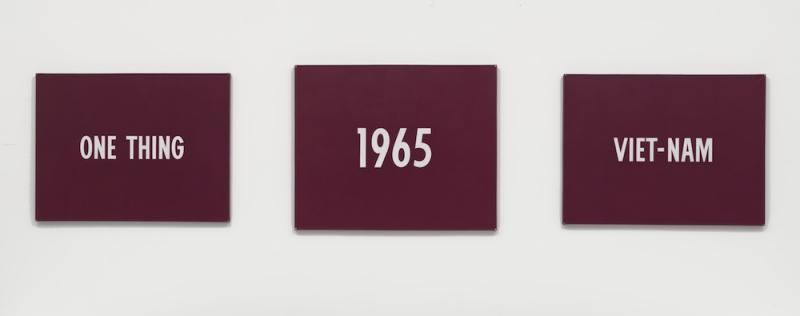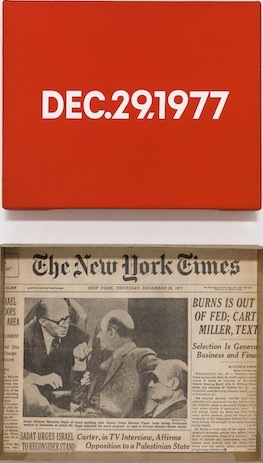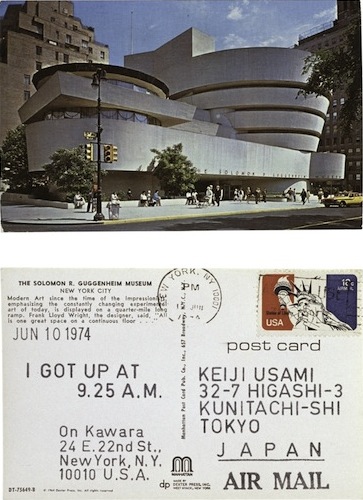theartsdesk in New York: On Kawara at the Guggenheim Museum | reviews, news & interviews
theartsdesk in New York: On Kawara at the Guggenheim Museum
theartsdesk in New York: On Kawara at the Guggenheim Museum
A powerful meditation on time through dating, mapping and listing

On a snowy day in early spring in New York, the On Kawara – Silence show at the Guggenheim is unlikely to warm you up. His date paintings, postcards, telegrams and other coldly ur-conceptual accountings spiral up those famous white Frank Lloyd Wright stairs, seemingly ad infinitum. But it’s a powerful, hypnotic experience, one that seeps into your subconscious and becomes a meditation on time and space.
On Kawara, who died last year in New York at the age of 81, almost never gave interviews or let himself be photographed. You won’t find him on YouTube, though you will find footage of people reading dates from his One Million Years: Past and One Million Years: Future project. "The sheer volume of numbers is overwhelming," comments one previous reader, adding that reading the dates "speaks time into being". It would take a hundred years to finish the reading of those two million dates, a strange concept in itself.
But the show, which was organised with his close collaboration, is dominated by his Today, or date, paintings. About three thousand times over a period of almost 50 years, from 1966 to 2013, Kawara painted the current date in white capital letters and numerals on to a blue, red or dark grey canvas, using Gill Sans and later Futura. If he didn’t finish the painting by the end of the day, he destroyed it. The date’s formula and punctuation varied according to where he was (he travelled constantly). If in the USA, then May 31 1970; if in France, then 31 Fev. 1970; in Germany, 24. März 1976; if in a non-Roman alphabet country, he used Esperanto. You get the picture. Sometimes the month is spelled out in full, sometimes shortened. And he refused to write in Japanese.
 The process wasn’t simple: those uniform numbers were hand drawn (no stencils) and the background colours were hand mixed and many layered, using Liquitex, allowed to dry between each coat and then rubbed down in preparation for the next. In glass cases below most of the paintings are cardboard boxes lined with the newspaper – often the New York Times – from the day of the painting (pictured left: DEC. 29, 1977 "Thursday". New York; courtesy of David Zwirner). There are also ring binders, called the I Read series, with newspaper clippings from the following day’s paper, a comment on the impossibility of now-ness: a newspaper, unlike digital media, can only report news from the previous day.
The process wasn’t simple: those uniform numbers were hand drawn (no stencils) and the background colours were hand mixed and many layered, using Liquitex, allowed to dry between each coat and then rubbed down in preparation for the next. In glass cases below most of the paintings are cardboard boxes lined with the newspaper – often the New York Times – from the day of the painting (pictured left: DEC. 29, 1977 "Thursday". New York; courtesy of David Zwirner). There are also ring binders, called the I Read series, with newspaper clippings from the following day’s paper, a comment on the impossibility of now-ness: a newspaper, unlike digital media, can only report news from the previous day.
Some front-page events are momentous, like the Apollo 11 moon landings, which accompany three particularly large dark-grey date paintings in July 1969, others not so much: the Queen visiting Japan in May 1975, the television schedule for November 8 1973. The smaller, grey paintings were usually done when he was travelling, for ease of transport and because grey was easier to mix; the larger, coloured ones were often done in New York in his studio at 405 East 13th Street. It’s disquieting and vertiginous to be surrounded by dates: all these one-time todays remind us how almost obsolete today always is. Maybe kids handle the void better: in 1998, in an ongoing project called Pure Consciousness, Kawara placed seven of the date paintings in kindergartens around the world (Goa in 2013 is the most recent). They are just used as a backdrop – no comments, no discussion, though you’d think some teachers might be tempted to use them to teach months and numbers.
Before he started the Today paintings, Kawara painted a precursor in 1965, a triptych called Title, with ONE THING, 1965, VIET-NAM spelled out across three magenta canvases (main picture). This was the year that the war escalated in Vietnam, so there is, unusually, an overt political message, perhaps reflecting Kawara’s childhood in Japan: he was profoundly affected, aged 13, by the Hiroshima and Nagasaki bombings. "Recently the notion of humanity has been threatened by matter. In daily life I feel this every moment," he said – a rare quote – in the 1950s, and this threat informs his work.
 "The serial artist does not attempt to produce a beautiful or mysterious object but functions merely as a clerk cataloguing the results of his premise," said Sol LeWitt in 1967. The starkly clerk-ish feel of the date paintings made me hungry for a bit of personal colour. At first, you think the I Got Up, I Met and I Went series may provide it. I Got Up is a collection of picture postcards sent, two a day, to various people from 1968 to 1979. The rubber-stamped format doesn’t vary: the date, ‘I got up at’ and then the time. (Pictured right: front and back of JUN 10 1975 from I Got Up, 1968–79; Keiji and Sawako Usami)
"The serial artist does not attempt to produce a beautiful or mysterious object but functions merely as a clerk cataloguing the results of his premise," said Sol LeWitt in 1967. The starkly clerk-ish feel of the date paintings made me hungry for a bit of personal colour. At first, you think the I Got Up, I Met and I Went series may provide it. I Got Up is a collection of picture postcards sent, two a day, to various people from 1968 to 1979. The rubber-stamped format doesn’t vary: the date, ‘I got up at’ and then the time. (Pictured right: front and back of JUN 10 1975 from I Got Up, 1968–79; Keiji and Sawako Usami)
The main excitement comes from seeing the names of the recipients – the curator Kasper König is a frequent one – and how varied the getting-up times are. When at the Mandarin in Hong Kong on Dec 24 1979 Kawara got up at 6.12am (postcard to Lili König, picture of Hong Kong street scene). But in New York on Apr 3 1969 he got up at 2.56 in the afternoon (card to Mr T Minemura in Tokyo, picture of Empire State building)! Partying? Jet-lagged? Late night playing mah-johngg, chess or Go, as was his wont? We’ll never know. In Hawaii on Jan 29 1971 he’s up at 4.07am. And so it goes on, a cataloguing system that more or less removes the personal. Guggenheim senior curator Jeffrey Weiss calls the postcards "a hilarious lampoon of touristic ennui" and perhaps I did notice a few chuckles.
I met, compiled between the same dates as I Got Up, lists the people that Kawara met each day. Names are typed into a single column – he saw them as a kind of ready-made poem – centered on a sheet of paper with the date stamped at the bottom. In I Went Kawara traced his movements every day on photocopied maps, all the same size, with red ballpoint pen. Twenty-four volumes of clothbound loose-leaf binders contain the maps, marking his path wherever he was. These series were brought to a suitably random end when Kawara’s briefcase containing his rubber stamps was stolen in Stockholm in September 1979 and he didn’t replace them.
He keeps a record of everything, and yet of his life we know nothing, as conceptual artist Daniel Buren observed. The series I am still alive continues the theme. Kawara sent a telegram – an unfamiliar object to some Guggenheim visitors – reading "I am still alive", 900 times between 1970 and 2000, when the medium became obsolete. Kind of the opposite of news. He didn’t branch into fax or email – not concrete enough, perhaps. And the appearance of each telegram varies according to the country where it was received: a record of where Kawara was not, rather than where he was, unlike the postcards.
On Kawara’s works entered my dreams after that Guggenheim visit. Dates spun like stars, rubber-stamped names and addresses whirled, columns of numbers disappeared into infinity. He expressed his own age in terms of the number of days he’d been alive at a show’s opening date. He missed the Guggenheim’s by about 220 days. When he died in late June last year, he tallied 29,771.
Share this article
The future of Arts Journalism
You can stop theartsdesk.com closing!
We urgently need financing to survive. Our fundraising drive has thus far raised £49,000 but we need to reach £100,000 or we will be forced to close. Please contribute here: https://gofund.me/c3f6033d
And if you can forward this information to anyone who might assist, we’d be grateful.

Subscribe to theartsdesk.com
Thank you for continuing to read our work on theartsdesk.com. For unlimited access to every article in its entirety, including our archive of more than 15,000 pieces, we're asking for £5 per month or £40 per year. We feel it's a very good deal, and hope you do too.
To take a subscription now simply click here.
And if you're looking for that extra gift for a friend or family member, why not treat them to a theartsdesk.com gift subscription?
more Visual arts
 'We are bowled over!' Thank you for your messages of love and support
Much-appreciated words of commendation from readers and the cultural community
'We are bowled over!' Thank you for your messages of love and support
Much-appreciated words of commendation from readers and the cultural community
 Photo Oxford 2025 review - photography all over the town
At last, a UK festival that takes photography seriously
Photo Oxford 2025 review - photography all over the town
At last, a UK festival that takes photography seriously
![SEX MONEY RACE RELIGION [2016] by Gilbert and George. Installation shot of Gilbert & George 21ST CENTURY PICTURES Hayward Gallery](https://theartsdesk.com/sites/default/files/styles/thumbnail/public/mastimages/Gilbert%20%26%20George_%2021ST%20CENTURY%20PICTURES.%20SEX%20MONEY%20RACE%20RELIGION%20%5B2016%5D.%20Photo_%20Mark%20Blower.%20Courtesy%20of%20the%20Gilbert%20%26%20George%20and%20the%20Hayward%20Gallery._0.jpg?itok=7tVsLyR-) Gilbert & George, 21st Century Pictures, Hayward Gallery review - brash, bright and not so beautiful
The couple's coloured photomontages shout louder than ever, causing sensory overload
Gilbert & George, 21st Century Pictures, Hayward Gallery review - brash, bright and not so beautiful
The couple's coloured photomontages shout louder than ever, causing sensory overload
 Lee Miller, Tate Britain review - an extraordinary career that remains an enigma
Fashion photographer, artist or war reporter; will the real Lee Miller please step forward?
Lee Miller, Tate Britain review - an extraordinary career that remains an enigma
Fashion photographer, artist or war reporter; will the real Lee Miller please step forward?
 Kerry James Marshall: The Histories, Royal Academy review - a triumphant celebration of blackness
Room after room of glorious paintings
Kerry James Marshall: The Histories, Royal Academy review - a triumphant celebration of blackness
Room after room of glorious paintings
 Folkestone Triennial 2025 - landscape, seascape, art lovers' escape
Locally rooted festival brings home many but not all global concerns
Folkestone Triennial 2025 - landscape, seascape, art lovers' escape
Locally rooted festival brings home many but not all global concerns
 Sir Brian Clarke (1953-2025) - a personal tribute
Remembering an artist with a gift for the transcendent
Sir Brian Clarke (1953-2025) - a personal tribute
Remembering an artist with a gift for the transcendent
 Emily Kam Kngwarray, Tate Modern review - glimpses of another world
Pictures that are an affirmation of belonging
Emily Kam Kngwarray, Tate Modern review - glimpses of another world
Pictures that are an affirmation of belonging
 Kiefer / Van Gogh, Royal Academy review - a pairing of opposites
Small scale intensity meets large scale melodrama
Kiefer / Van Gogh, Royal Academy review - a pairing of opposites
Small scale intensity meets large scale melodrama
 Jenny Saville: The Anatomy of Painting, National Portrait Gallery review - a protégé losing her way
A brilliant painter in search of a worthwhile subject
Jenny Saville: The Anatomy of Painting, National Portrait Gallery review - a protégé losing her way
A brilliant painter in search of a worthwhile subject
 Abstract Erotic, Courtauld Gallery review - sculpture that is sensuous, funny and subversive
Testing the boundaries of good taste, and winning
Abstract Erotic, Courtauld Gallery review - sculpture that is sensuous, funny and subversive
Testing the boundaries of good taste, and winning
 Edward Burra, Tate Britain review - watercolour made mainstream
Social satire with a nasty bite
Edward Burra, Tate Britain review - watercolour made mainstream
Social satire with a nasty bite

Add comment